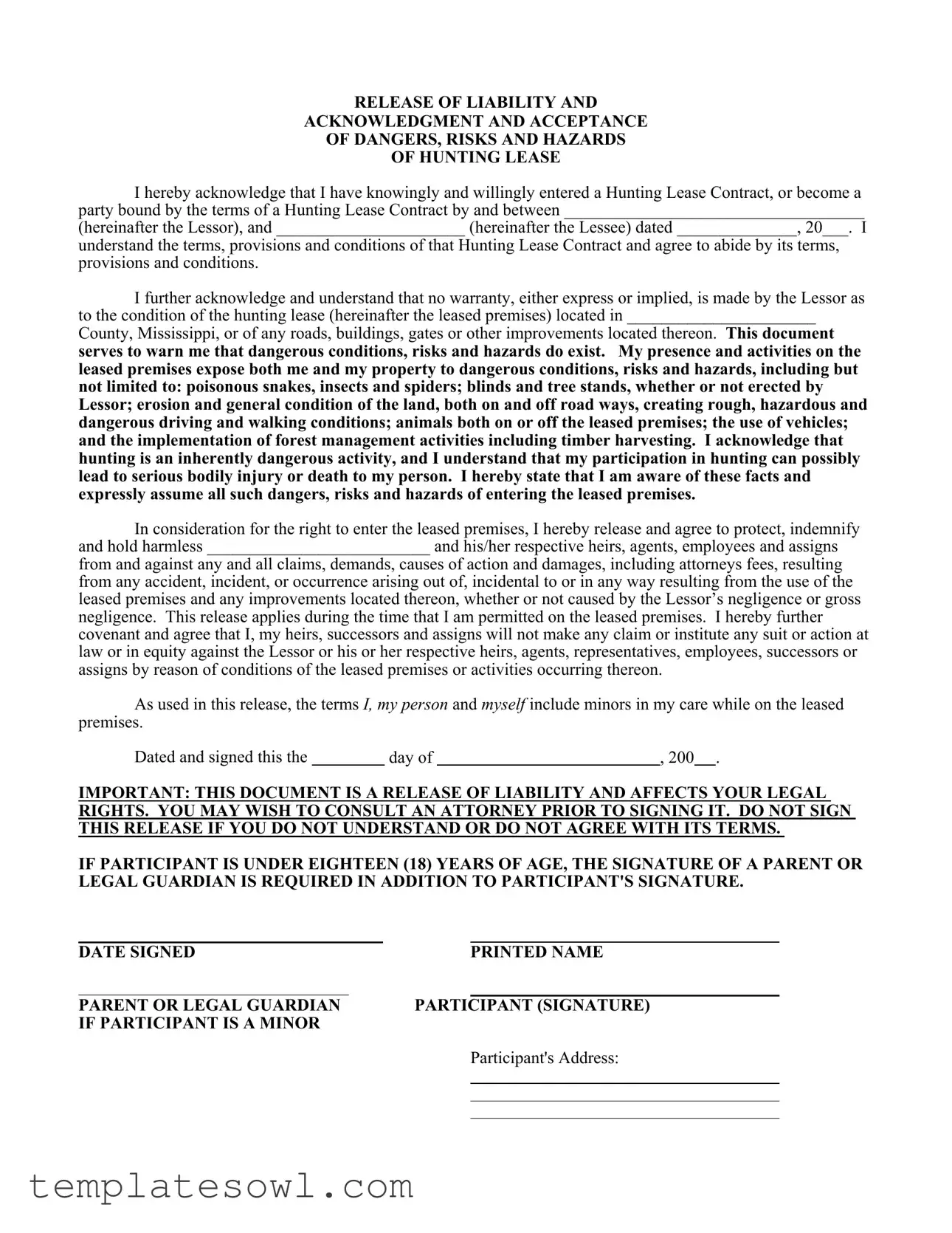RELEASE OF LIABILITY AND
ACKNOWLEDGMENT AND ACCEPTANCE
OF DANGERS, RISKS AND HAZARDS
OF HUNTING LEASE
I hereby acknowledge that I have knowingly and willingly entered a Hunting Lease Contract, or become a party bound by the terms of a Hunting Lease Contract by and between ___________________________________
(hereinafter the Lessor), and ______________________ (hereinafter the Lessee) dated ______________, 20___. I
understand the terms, provisions and conditions of that Hunting Lease Contract and agree to abide by its terms, provisions and conditions.
I further acknowledge and understand that no warranty, either express or implied, is made by the Lessor as to the condition of the hunting lease (hereinafter the leased premises) located in ______________________
County, Mississippi, or of any roads, buildings, gates or other improvements located thereon. This document serves to warn me that dangerous conditions, risks and hazards do exist. My presence and activities on the leased premises expose both me and my property to dangerous conditions, risks and hazards, including but not limited to: poisonous snakes, insects and spiders; blinds and tree stands, whether or not erected by Lessor; erosion and general condition of the land, both on and off road ways, creating rough, hazardous and dangerous driving and walking conditions; animals both on or off the leased premises; the use of vehicles; and the implementation of forest management activities including timber harvesting. I acknowledge that hunting is an inherently dangerous activity, and I understand that my participation in hunting can possibly lead to serious bodily injury or death to my person. I hereby state that I am aware of these facts and expressly assume all such dangers, risks and hazards of entering the leased premises.
In consideration for the right to enter the leased premises, I hereby release and agree to protect, indemnify and hold harmless __________________________ and his/her respective heirs, agents, employees and assigns
from and against any and all claims, demands, causes of action and damages, including attorneys fees, resulting from any accident, incident, or occurrence arising out of, incidental to or in any way resulting from the use of the leased premises and any improvements located thereon, whether or not caused by the Lessor’s negligence or gross negligence. This release applies during the time that I am permitted on the leased premises. I hereby further covenant and agree that I, my heirs, successors and assigns will not make any claim or institute any suit or action at law or in equity against the Lessor or his or her respective heirs, agents, representatives, employees, successors or assigns by reason of conditions of the leased premises or activities occurring thereon.
As used in this release, the terms I, my person and myself include minors in my care while on the leased premises.
Dated and signed this the |
|
day of |
|
, 200 . |
|
|
|
|
|
|
|
IMPORTANT: THIS DOCUMENT IS A RELEASE OF LIABILITY AND AFFECTS YOUR LEGAL RIGHTS. YOU MAY WISH TO CONSULT AN ATTORNEY PRIOR TO SIGNING IT. DO NOT SIGN THIS RELEASE IF YOU DO NOT UNDERSTAND OR DO NOT AGREE WITH ITS TERMS.
IF PARTICIPANT IS UNDER EIGHTEEN (18) YEARS OF AGE, THE SIGNATURE OF A PARENT OR LEGAL GUARDIAN IS REQUIRED IN ADDITION TO PARTICIPANT'S SIGNATURE.
DATE SIGNED |
|
PRINTED NAME |
|
|
|
PARENT OR LEGAL GUARDIAN |
PARTICIPANT (SIGNATURE) |
IF PARTICIPANT IS A MINOR |
|
|
|
|
Participant's Address: |
|
|
|
|
|
|
|
|
|

